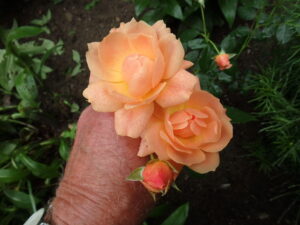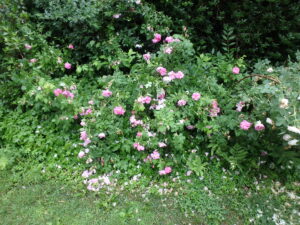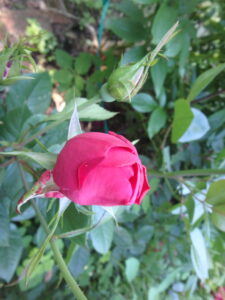Roses 101: They Are Easier to Grow Than You Might Think
Posted on Tuesday, June 30, 2020 · Leave a Comment
I love roses, but avoided planting any for a long time. They had a reputation for being fussy. I thought they would attract Japanese beetles, and carry black spot and other diseases. In recent years I have been enjoying growing roses and find that modern breeders have come up with many fine roses that are easy to grow, and not fussy.

At Last is a re-blooming hybrid developed by Proven Winners. It’s a Zone 5 plant that I’ve had for 4 years in Zone 4
So what have I learned? First, roses love full sun, but will grow in part shade. But the more sun they get, the better they do. Six hours of sunshine is considered full sun by most authorities. Afternoon sun is more potent than morning sun, so the west side of the house is better than the east.
Second, roses need good, rich soil. If you have sandy soil or a heavy clay, you will need to improve it in order to succeed. What does that mean? Dig a hole that is at least 3 times as wide as the pot it was in when you purchased it. If your rose came in an 8-inch pot, a 24-inch hole should be the minimum you dig.
The late Mike Lowe, a rosarian who grew 2,000 kinds of roses in Nashua, NH, told me to dig a hole 36 inches wide and 24 inches deep – if possible. If you have heavy clay, he said, put a couple of inches of pea stone in the bottom of the hole for drainage. The fill it with an equal mix of topsoil and compost.
When planting a tree, it is important to dig a hole shallow enough so that the tree does not get its trunk flare buried. The trunk flare is the portion of the tree that was above ground when it was growing before it was potted up for sale. Often that trunk flare is covered with soil when you buy it, and needs to be exposed.
Not so, for roses.

This old fashioned fragrant rose blooms but once but it is lovely
Many roses are grafted onto rootstock. The bud union – a scar – should be buried in the soil. The colder the climate, the deeper that graft line or bud union should be. For Zone 4, it should be about 4 inches below the final soil line. Zone 5? 3 inches. Zone 6? 2 inches.
Third, roses like soil that is just slightly acidic – pH 6.0 to 6.8. If you have acidic soil, say somewhere in the 5.0 to 6.0 range, you should add limestone to bring up the soil pH and make it less acidic. Mike Lowe suggested burying a 3-inch square of gypsum wallboard directly below each rose to provide limestone over the long haul. I’m not sure just how effective that is.
Don’t know your soil pH? You can get an inexpensive pH testing kit at your local garden center. Or you can send a sample to your State University Extension Service.
Roses need more water than most other things, but do not want to sit in soggy soil. They should get an inch of water per week from rain, or a couple of watering cans of water applied slowly so it can soak in. A deep watering once a week is better than a little sprinkle every day.
I called Mike and Angie Chute of East Providence, Rhode Island to pick their brains about roses. They have been growing roses for 25 years, and are the authors of
Roses for New England: A Guide to Sustainable Rose Gardening. They are well known speakers at the spring flower shows. Their web site is www.rosesolutions.net , and it’s worth visiting.
I asked them what they thought of the new roses that have been developed in the last 25 years, and how they rate them against the old heritage roses. Mike explained that the trademarked “Knock Out” roses have become immensely popular. I have some, and agree that they are wonderful. They bloom most of the summer and well into the fall, seem to get no diseases and do not attract pests.

This Knockout rose blooms all summer
On the other hand, most of the Knock Out roses have no fragrance, and do not have the long stems that lovers want to present to their sweeties. Mike and Angie grow them, along with 150 other kinds of roses, and said that the “Easy Elegance” series of roses is at least as good, and maybe better.
Want more blossoms? Mike said that roses do better if they get some fertilizer a few times during the course of the summer. They use chemical fertilizer, a 10-10-10 for a “kick in the pants”, and mulch with chopped seaweed. They like an organic, slow-release bagged fertilizer called Rose Tone, and sometimes use liquid fish and seaweed fertilizers made by Neptune’s Harvest.
My roses grow in good soil, and I have been neglectful of them – I rarely fertilize. But I understand that a dose of liquid fish and seaweed fertilizer 2 or 3 times in the summer might help. I’ll do it this weekend.
Want to learn more? The Chute’s book, mentioned above, is excellent, and worth reading. I also like one published by Rodale Press in 2002, Growing Roses Organically: Your Guide to Creating an Easy-Care Garden Full of Fragrance and Beauty by Barbara Wilde. It has a half-page description with a photo of each of 100 roses that will do well with organic care.
June is over, but roses are not. Now days, many roses will re-bloom every 45 days or so, and some bloom almost constantly. Just be sure to cut off spent blossoms, and down to another shoot with 5 leaves or more.
Henry is the author of 4 gardening books and is a veteran of the UNH Master Gardener program. His email is
henry.homeyer@comcast.net.





